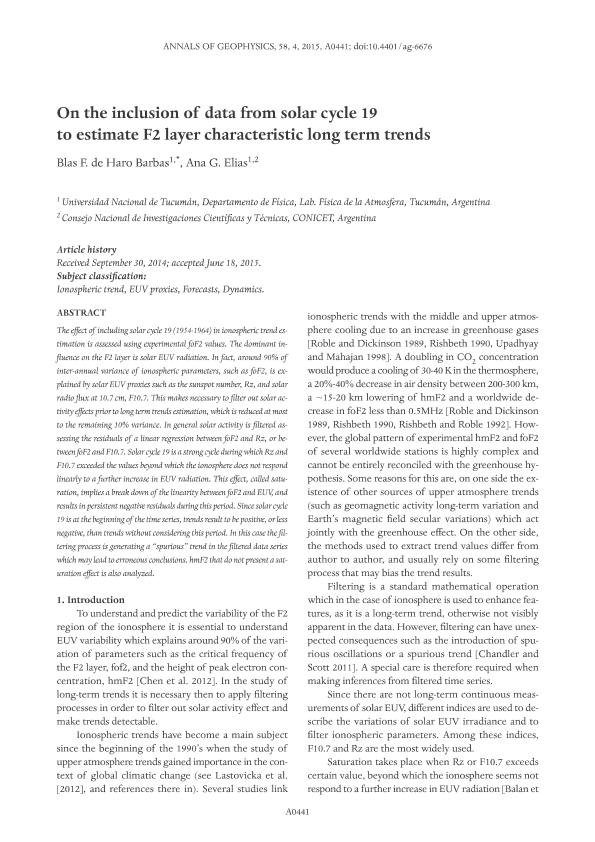Mostrar el registro sencillo del ítem
dc.contributor.author
de Haro Barbás, Blas Federico

dc.contributor.author
Elias, Ana Georgina

dc.date.available
2019-05-28T19:12:57Z
dc.date.issued
2015-04
dc.identifier.citation
de Haro Barbás, Blas Federico; Elias, Ana Georgina; On the inclusion of data from solar cycle 19 to estimate F2 layer characteristic long term trend; Editrice Compositori Bologna; Annals Of Geophysics; 58; 4; 4-2015; 1-6
dc.identifier.issn
1593-5213
dc.identifier.uri
http://hdl.handle.net/11336/77351
dc.description.abstract
The effect of including solar cycle 19 (1954-1964) in ionospheric trend estimation is assessed using experimental foF2 values. The dominant influenceon the F2 layer is solar EUV radiation. In fact, around 90% of inter-annual variance of ionospheric parameters, such as foF2, is explained by solar EUV proxies such as the sunspot number, Rz, and solar radio flux at 10.7 cm, F10.7. This makes necessary to filter out solar activity effects prior to long term trends estimation, which is reduced at most to the remaining 10% variance. In general solar activity is filtered assessing the residuals of a linear regression between foF2 and Rz, or between foF2 and F10.7. Solar cycle 19 is a strong cycle during which Rz and F10.7 exceeded the values beyond which the ionosphere does not respond linearly to a further increase in EUV radiation. This effect, called saturation, implies a break down of the linearity between foF2 and EUV, and results in persistent negative residuals during this period. Since solar cycle 19 is at the beginning of the time series, trends result to be positive, or less negative, than trends without considering this period. In this case the filtering process is generating a ?spurious? trend in the filtered data series which may lead to erroneous conclusions. hmF2 that do not present a saturation effect is also analyzed.
dc.format
application/pdf
dc.language.iso
eng
dc.publisher
Editrice Compositori Bologna

dc.rights
info:eu-repo/semantics/openAccess
dc.rights.uri
https://creativecommons.org/licenses/by-nc-sa/2.5/ar/
dc.subject
Ionospheric Trends
dc.subject
Euv Proxies
dc.subject
Solar Cycle
dc.subject
F2 Region
dc.subject.classification
Meteorología y Ciencias Atmosféricas

dc.subject.classification
Ciencias de la Tierra y relacionadas con el Medio Ambiente

dc.subject.classification
CIENCIAS NATURALES Y EXACTAS

dc.title
On the inclusion of data from solar cycle 19 to estimate F2 layer characteristic long term trend
dc.type
info:eu-repo/semantics/article
dc.type
info:ar-repo/semantics/artículo
dc.type
info:eu-repo/semantics/publishedVersion
dc.date.updated
2019-05-23T19:09:52Z
dc.identifier.eissn
2037-416X
dc.journal.volume
58
dc.journal.number
4
dc.journal.pagination
1-6
dc.journal.pais
Italia

dc.journal.ciudad
Bologna
dc.description.fil
Fil: de Haro Barbás, Blas Federico. Universidad Nacional de Tucumán. Facultad de Ciencias Exactas y Tecnología; Argentina
dc.description.fil
Fil: Elias, Ana Georgina. Universidad Nacional de Tucumán. Facultad de Ciencias Exactas y Tecnología; Argentina. Consejo Nacional de Investigaciones Científicas y Técnicas. Centro Científico Tecnológico Conicet - Tucumán; Argentina
dc.journal.title
Annals Of Geophysics

dc.relation.alternativeid
info:eu-repo/semantics/altIdentifier/doi/https://dx.doi.org/10.4401/ag-6676
dc.relation.alternativeid
info:eu-repo/semantics/altIdentifier/url/https://www.annalsofgeophysics.eu/index.php/annals/article/view/6676/6533
Archivos asociados
